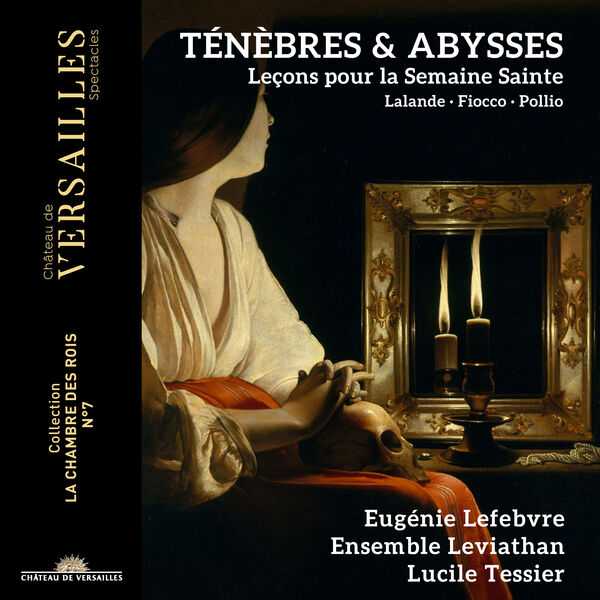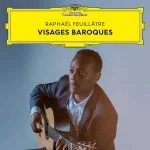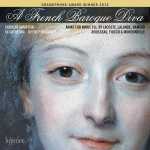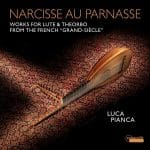

Composer: Hector-Joseph Fiocco, Jean-Baptiste Forqueray, Antoine Forqueray, Pierre-Louis Pollio, Joseph Bodin de Boismortier, Joseph Michel, Michel-Richard de Lalande
Performer: Julie Dessaint, Eugénie Lefebvre, Loris Barrucand, Clément Geoffroy, Camille Dupont, Lucile Tessier, Ensemble Leviathan
Format: FLAC (tracks)
Label: hâteau de Versailles Spectacles
Catalogue: CVS095
Release: 2023
Size: 1.08 GB
Recovery: +3%
Scan: yes
Ténèbres et Abysses
01. Fiocco: De lamentatione – Teth
02. Fiocco: Defixae sunt
03. Fiocco: Jod – Sederunt in terra
04. Fiocco: Defecerunt – Jerusalem
05. Forqueray: Allemande
06. Forqueray: Courante
07. Forqueray: Sarabande
08. Pollio: Incipit Lamentatio
09. Pollio: Aleph – Quomodo sedet – Beth – Plorans – Omnes amici ejus
10. Pollio: Viae Sion lugent – He
11. Pollio: Facti sunt hostes ejus
12. Pollio: Jerusalem
13. Boismortier: Doucement
14. Boismortier: Courante
15. Boismortier: Allemande
16. Boismortier: Premier Menuet – Deuxième Menuet
17. Lalande: Michel: Jerusalem
18. Lalande: Incipit oratio
19. Lalande: Recordare
20. Lalande: Pupilli facti sumus – Cervicibus nostris – Lassis non dabatus – Recordare – Aegypto dedimus
21. Lalande: In animabus nostris
22. Lalande: Pellis nostra – Mulieres in Sion – Recordare – Jerusalem
During the 17th and 18th centuries, Europe knew different traditions with regard to the performance of music for Passiontide. Protestant Germany had its oratorios, either based on the narrative of Jesus’s suffering and death in the Gospels (Bach) or rather paraphrases of it (Brockes-Passion). Many Italian composers set the text of the Stabat mater, an account of the suffering of Jesus’s mother Mary, seeing her son hanging at the Cross. In France, although also Catholic like Italy, only a few composers seem to have written such works: Henry du Mont, Lully and Lalande, to mention some of the main composers of sacred music, never set this text. French composers rather turned to the lamentations of Jeremiah, since early times part of the liturgy for the three last days of Holy Week, known as Triduum Sacrum. Charpentier was one of those whose oeuvre includes a large number of Leçons de Ténèbres, as they were called, and among the best-known pieces of this kind are those by François Couperin. The disc under review here includes some settings that are far less well-known, and even some of the composers may be unknown quantities to most music-lovers.
That goes in particular for Pierre-Louis Pollio, who is the latest composer in the programme. According to the liner-notes, his oeuvre is substantial and has been rediscovered only recently. He occupied some minor positions in Aire-sur-la-Lys and Péronne, then directed the Sainte-Chapelle in Dijon (1751-1762) and was then appointed maître de chapelle at Beauvais Cathedral (1762-1767). Next he moved to the Collegiate church of Soignies (1767-1784) and spent the last years of his life copying his works, among which several complete sets of Leçons de Ténèbres. The first lesson for Holy Saturday is promising, and includes marked dramatic traces, showing the influence of the Italian style, which became increasingly popular in France during the second half of the 18th century.
Pollio was a pupil of another little-known master, Joseph Michel. It is not known when and where he was born, but he died in Dijon in 1736. As he had also studied there, it seems likely that he was also born in or near Dijon. From 1709 until is death he worked as maître de musique du roi at the Sainte-Chapelle there. Not that many music from his pen has survived. He is known to have written three grands motets in the style common at the Chapelle Royale in Versailles; one of them has been lost. He also composed several sets of Leçons de Ténèbres, which he offered in different versions for a variety of voices. It is disappointing that here we get only a short fragment from one of them, which makes it hardly possible to get a good impression of what this part of his oeuvre has to offer.
The programme opens with a Leçon de Ténèbres by Joseph-Henry Fiocco, who was neither of French birth nor working in France, but rather in the Austrian Netherlands, what is now known as Belgium. He was born in Brussels; he was the eighth child of Pietro Antonio, who was from Venice and whose presence in Brussels is documented as early as 1682. For most of his life the latter was in the service of Maximilian Emanuel, Elector of Bavaria, who became governor of the Southern Netherlands in 1692. Joseph Hector first served the ducal chapel under his half-brother Jean-Joseph and became sous-maître in 1729 or 1730. In 1731 he settled in Antwerp, where he took up the position of choirmaster at the Cathedral, as successor to Willem de Fesch, who had moved to England. In 1737 he returned to Brussels, where he succeeded Pierre Hercule Bréhy as choirmaster of the collegiate church of St Michel and Ste Gudule. Part of his duties was the training of the choirboys. He died at the young age of 38. Fiocco left a complete set of nine Leçons de Ténèbres, which show a mixture of the French and the Italian style. It is notable that all settings include an obbligato part for a cello, and some for two cellos. This must have been the reason that the performers turned to his settings, as the role of the low instruments, in particular the cello and the bassoon, can be considered the main subject of this recording.
The liner-notes, by Lucile Tessier and Fabien Guilloux respectively, explain at length the importance of the basso continuo, and the way it has to or can be realised, and the instruments which can participate in it. The title of Guilloux’s essay sums it up: “The repertoire with basse obligée“. In some music of the 18th century the basso continuo is more than just the (harmonic and rhythmic) support of singers and/or instrumentalists. He states that improvisation techniques are very familiar to players of keyboard and plucked instruments, but not to players of bowed string instruments and winds. However, there is much evidence of their role in the basso continuo, which goes beyond simply supporting the chordal instruments. “It was common for the serpent, bassoon, cello or even double bass players who accompanied the choir to improvise on the plainchant line in the same way as the singers; indeed, such skills were both sought and expected by employers.” He refers to the musical library of the chapter of Saint-Vincent in Soignies (Belgium), which includes performance material that consists of separate and distinct bass parts for instruments such as the serpent, the bassoon and the cello. “A large majority are marked with the use of improvisation techniques and processes and were no doubt intended for young instrumentalists to compensate for their inexperience. Based on this theory, we see that not only were musicians able to improvise accompaniments from the bass line based on stereotypical arpeggio formulas, but also to invent autonomous paths and brief instrumental ritornellos (preludes, interludes, postludes) by taking elements from the base line or the singers’ vocal parts.”
This explains the marked role of the bass instruments. In the Leçons de Ténèbres, the performers here and there insert instrumental improvisations; to what extent that is indicated in the score is impossible to say, as most of the pieces performed here are hardly known. The low instruments are on their own in the instrumental pieces. A suite for three viole da gamba by one of the Forquerays is performed here with bassoon and two string basses. A sonata for three transverse flutes has been transcribed for bassoon, viola da gamba, cello and basso continuo.
The programme closes with one of Lalande’s Leçons de Ténèbres, and that is the most French setting of the three. It is in a purely French style, and one understands why Lalande was Louis XIV’s favourite composer of sacred music.
It brings to an end a very interesting account of French music, both vocal and instrumental, and of performance practises that are hardly known, but deserve thorough examination. Whether there is enough historical evidence of the arrangements as practised here, we shall see. Whatever is the case, it is all very well done, and the performers deliver excellent and often exciting performances. Eugéne Lefebvre deserves accolades for the way she performs the vocal parts, which is very differentiated: dramatic when it is needed, but much more restrained when the text and the way composers have set it, asks for it. I definitely hope to hear more of Pollio: as his oeuvre is as large as is suggested, we can expect quite some surprises.



